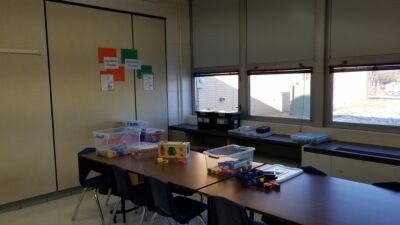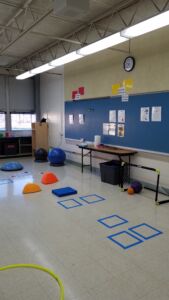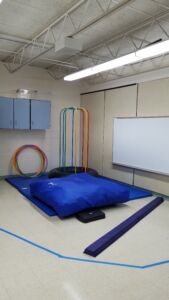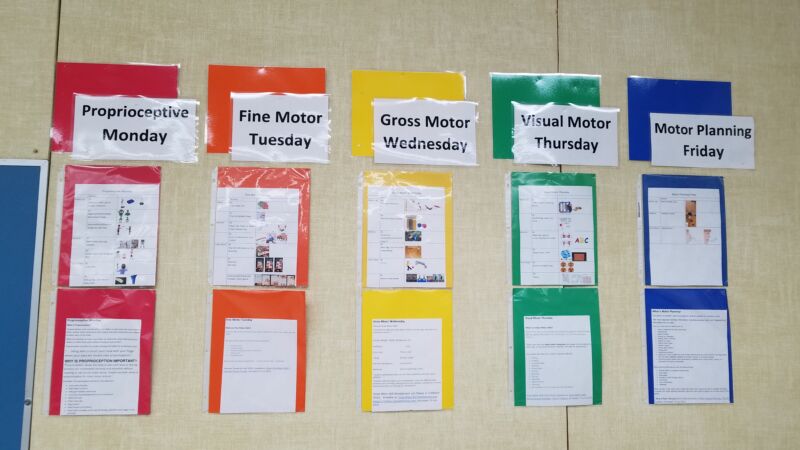Table of Contents
Tying our shoes. The ability to literally jump for joy or run at recess. These are examples of fine and gross motor skills, which are foundational to a person’s ability to interact with their environment. For students in special education, targeted motor skill development can pave the way for enhanced learning experiences and a higher quality of life.
Given the importance of these skills, the High Road School of the South Suburbs recently unveiled a new motor lab where students can further develop their motor skills and an understanding of their environment.
Addressing the five skill areas

 Occupational Therapist Sunny Eartly said the motor lab is designed make up a portion of a student’s daily schedule, focusing on one skill area each day of the week. Specific warm ups, activities, and cool downs target each of the five skill areas addressed in the motor lab – proprioceptive, fine motor skills, gross motor skills, visual motor skills and motor planning – all of which are important for educational and life success.
Occupational Therapist Sunny Eartly said the motor lab is designed make up a portion of a student’s daily schedule, focusing on one skill area each day of the week. Specific warm ups, activities, and cool downs target each of the five skill areas addressed in the motor lab – proprioceptive, fine motor skills, gross motor skills, visual motor skills and motor planning – all of which are important for educational and life success.
A student’s time in the motor lab can either be one-on-one with staff member or completed with a limited number of peers and a teacher. The rotation can last up to 20 minutes depending on the students’ abilities and level of participation that day. The warm ups, activities, and cool downs remain the same for nine to 12 weeks, allowing for growth and improvement. Additionally, new warm ups, activities, and cool downs are added every nine to 12 weeks, helping address the five motor skill areas through a variety of ways.
Using the motor lab to gain independence
The skills a student learns in each modality are generalized and transition with them to the next area. The end goal is to ensure that the skills students learn can be utilized in new environments, influencing their ability to be independent in real-life encounters.
“I wanted to have options for activities in each skill area as our kids do better being able to make a choice on what it is they want to do,” Eartly said. “We see a difference in a lot of the students’ abilities, most who are nonverbal, and their skills and how it’s carrying over to other areas.”
Eartly color coded the daily schedule by skill and theme to make things more understandable for the students. Activities are adapted to beginner, intermediate and advanced levels. The schedule is posted both outside and inside the room along with pictures of each activity.

Meeting the needs of all students
The motor lab serves students with significant autism and developmental delays participating in both the Partial Academic and Life Skills (PALS) and Broad-Based Educational Services and Therapies (B.E.S.T) models. For those students with significant autism and developmental disabilities, the B.E.S.T model takes learned skills and practically applies them to the multiple environments in which a student can apply what they’ve learned. Students spends portions of their day rotating through different modalities of instruction, the length and the frequency of each rotation is individuality designed for each learner and based on their current skills and future goals.
The PALS model is an individualized hybrid of the Academic Rotation model and the BEST model. Students in this model receive customized instruction and programming based on their individual needs. For example, some students focus more on academic instruction, while others may require more intensive BEST programming involving life and social skills. Depending on their assessments and individual needs, students will always receive a combination of both models within a PALS learning environment.
High Road School of the South Suburbs provides academic and therapeutic services for children, adolescents, and young adults, ages 3 through 21, with extraordinary needs. The staff and teachers believe students reach their highest potential in safe and structured environments that afford them a strong sense of security, a positive attitude toward learning, and incentives for appropriate behavior. By focusing on key areas — academics, behavior modifications, support services, and transition/life-planning services — they meet the individual needs of all students.
